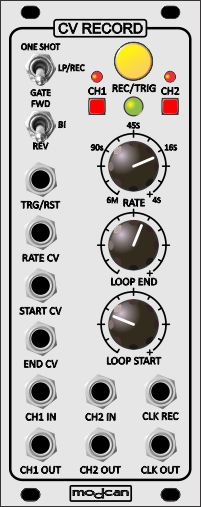
The CV Recorder does for Control Voltage what samplers do for audio, providing the user with the ability to record CV signals from sequencers, joysticks, LFOs, Envelopes and anything else that will create a CV voltage. Audio can also be recorded directly with good sound quality at the higher sample rates but lacks the anti-alias filtering typical with a dedicated audio sampler.
The resulting recording can then be looped and speed shifted manually or with external CV to create new types of CV events to control other modules.
Recordings can be done in one pass or multiple short "takes" to create complex signals.
The Reset jack can be used to trigger recording start making it easier to create a looping pattern when using the same trigger to reset the sample playback.
The Loop end and Loop start controls set the start and end of a recording in memory and also the loop start and end of the sample playback. Granular synthesis type effects can be had by CV controlling the loop points in real-time.
Changing the sample rate changes the speed of playback and also the sample rate during recording. In signal thru mode the sample rate can be varied dynamically between 44.1Khz (audio quality) at its highest sample rate, down to 400Hz at its lowest to produce lo-fi effects in real-time.
The playback can be a loop between start and end points or can be a gated or triggered one shot event like an envelope.
The sample can be played forward and reverse and and bi-directional pendulum mode.
Two channels of CV or audio recording for stereo or dual mono signals and a third channel for clock or sync signals. The third channel makes it possible to record sequence voltages with channels 1 and 2 and the 3rd channel for sequence clock allowing the CV recording to synchronize the firing of envelopes and to function as a clock recorder.
The Stereo sample time available is between 4 seconds at 44.1k to 6 minutes at 400Hz. The channel selection buttons permit the user to record each channel separately or together. When both channels are selected the Clock channel is also enabled for recording.
A pulse at the Trig/Reset jack resets the sample playback to the position set by the loop start knob in loop mode. In One shot mode a pulse at the Trig/Reset jack starts the sample playback at the loop start point and plays it to the end loop point as set by the start and end knobs.
In Gate mode the recording will play for as long as the Trig/Reset jack is held high (5V) and will loop at the current start and end settings.
There is also the ability to save recordings between sessions.
The number of different ways to use the CV Record module is vast and once the full capabilities of the module become apparent it will change the way you patch your modular.
- CV Record features:
- Two channels of CV recording and third for clocks
- 4 seconds at 44.1kHz to 6 minutes at 400Hz sample rate
- Memory backup for samples between power cycles
- Real-time CV control of sample loop start and end points
- External trigger and gate modes
- Continuously variable sample rate and playback speed
- Forward, Reverse and pendulum sample playback
- Trigger and Reset control of sample start
- Multiple short samples can be recorded to make long sample
- Mode and direction selection switch's
- Real-time signal processing for sample rate FX
- Can be used for granular type synthesis
- 10HP wide shallow depth approx 1"
Firmware by Bruce Duncan
Specs:
Sample rate 44.1kHz - 400Hz
Sample Input +/-7V Output +/-7V
CV control jack range 0-10V
Current 90mA@+12V, 10mA@-12V
CV Demo MP3s
Wonky
Vocalize
Quadnoodle
GranularCV
Formant
Chained
Lumpy
Sequence
Simple
Quad
LFO1
LFO2
Loopmode
Seq3
This sequence was recorded using the VC Sequencer 54B
into the Quantizer 55B. The voltage steps for the VCDO pitch and FM index and sequencer pulse out were recorded and looped
by the CV Recorder. The sliders on the sequencer were tweaked and recorded with each successive pass.
Audio Demos
Audio1
Audio2
Granularvox
OneShotMode